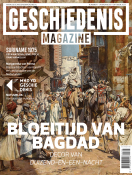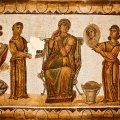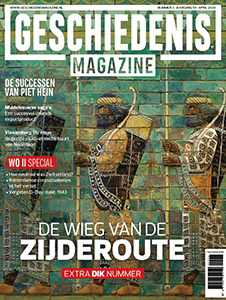
Ethnic and black nationalism in South Africa
 In the early nineteenth Century, Shaka Zulu was able to create a powerful kingdom in the east of modern South Africa. In so doing, this new Zulu king took over the powers of the lower Chiefs and the ideological position as "father" of their people. He became responsible for the well-being of his subjects, and for the redistribution of agricultural production. Moreover, as a king, he was the symbol of the people's unity.
In the early nineteenth Century, Shaka Zulu was able to create a powerful kingdom in the east of modern South Africa. In so doing, this new Zulu king took over the powers of the lower Chiefs and the ideological position as "father" of their people. He became responsible for the well-being of his subjects, and for the redistribution of agricultural production. Moreover, as a king, he was the symbol of the people's unity.
Door: Teun Baartman
Shaka's successors managed to hold the kingdom together until 1879, when the Zulu were conquered by the British and their guns. In the reorganisation after the conquest, the Zulu kings lost most of their powers. When king Dinuzulu died in 1913, his successor, Solomon ka Dinuzulu, was not even recognised by the South African government as the official leader of the Zulu. But he was supported by the greater part of his people, because they expected him to protect them against the white laws. Everywhere he came, he was treated as the king. The white government saw this and decided to make use of Solomon's influence by employing him as a mediator in certain conflicts with the Zulu population.
This co-optation of Solomon fitted well into the framework of the "retribalisation policy", expounded by the South African government from the 1920s. The purpose of this policy was to keep the Africans together within their respective tribal boundaries under the authority of their Chiefs, so that it was easier for the white government to keep an eye on them. Part of the policy was to stimulate an ethnic consciousness among the blacks, for if one was to feel oneself a member of a tribe, one had to be proud of the traditions and institutions of that tribe and of one's own nation.
There were also black leaders, who, in the 1920s and 1930s, tried to use the central status of Solomon. They included George Champion, president of the Industrial and Commercial Worker's Union Yase Natal and John Dube, leader of the Christian black elite, the kholwa, in Natal. These men associated themselves with the king to gain support from the Zulu population. They needed this support to strengthen their own position within the political structures of Natal. Dube was one of the founders of an organisation, Inkatha ya ka Zulu (1922), the purpose of which was to unite the Zulu round the central figure of king Solomon and, in connection with that, to revive the Zulu national consciousness.[1]
It would seem that, in the first third of the twentieth Century, both black and white leaders had to work to promote ethnic consciousness, even among the Zulu, whose sense of nationhood was, prima facie, the strongest of all the African groups in South Africa. This would suggest that, by then, ethnic feeling even in this most solid of South African black nations was not strong and required resuscitation or perhaps even création. In this paper, I will discuss whether this low level of ethnicity has continued into the 1970s and 1980s and how political leaders, both black and white, have reacted to it.
Ethnic Policy
The first thing to note is that the South African government never abandoned the ethnic policy. Nowadays it is called a "policy of separate development", which is characterized by Roelof Botha, Foreign Minister of South Africa, when he says: "The problem in Southern Africa is not one of race, but of nationalism... There is a white nationalism, and there are several black nationalisms".[2] The government maintains that the blacks are divided into several ethnic groups (Tswana, North-Sotho, Ndebele, Tsonga, Venda, Swazi, South-Sotho, Zulu and Xhosa). Each group has an unchangeable culture and identity and therefore the government assigned each of them a "homeland", where they can go through their own development, at the end of which these homelands will become independent states. Needless to say, the so-called independent homelands are in reality very dependent on South Africa.
It is true that one can distinguish several smaller ethnic groups in South Africa, but in contrast to the ideas of the white government, these are not closed groups with firm boundaries. They have a common cultural and linguistic legacy, since they are all speakers of closely related Bantu languages. There was and is regular communication and interaction between them. The Chiefs of the past never did draw such clear boundaries. They conquered other groups, absorbed them and formed new ones. During the rise of Shaka, many groups fled to other territories and adopted the customs of local people. There never were insuperable ethnic differences between blacks. The ethnic policy of the white government changed this, because it stressed the minor differences that did exist. Obviously, this policy is not based on a thorough scientific study of the black people, but, as has become clear the last decades, rather serves certain economic and political purposes.
Secondly, black leaders react roughly in two ways to the ethnic policy of the South African government. Some go the same way as Solomon and John Dube and stimulate ethnic nationalism. We will discuss one of them later. But there are also leaders who follow the route of black nationalism. They want to unite all blacks and indeed all South Africans, regardless of ethnic background, in the struggle against the apartheid regime. They believe that during this struggle, ethnic consciousness will become extinct. Some black nationalist organizations are multi- racial (also including whites, coloureds and Indians), like the African National Congress (ANC) and the United Democratie Front (UDF). Other ones are for blacks only, like the Azanian People's Organisation (AZAPO).
Although black nationalism has existed for a long time past (the ANC was founded in 1912), it got an important impulse in the idea of Black Consciousness, which was framed for a large part by Steve Biko in the 1970s. Biko stated that the Blacks (by which he meant ail oppressed groups in South Africa, including Coloureds and Indians) had been subject to the most extreme forms of social, political and economic oppression for generations. The resuit was that the black man acquiesced in it; he became "an ox bearing the yoke of oppression with sheepish timidity".[3] The thing to do was to make him conscious of this and to let him see that he was not inferior to the white man. He could be proud of himself and of his cultural background. The ultimate goals of Black Consciousness are the liberation of the black people and the achievement of Black Unity; "We are oppressed not as individuals, not as Zulus, Xhosas, Vendas or Indians. We are oppressed because we are black. We must use that very concept to unite ourselves and to respond as a cohesive group". [5]
Black nationalist leaders oppose the policy of resettling blacks in homelands. According to them, the homelands are designed to boost the intertribal competition and hostility and this distracts the blacks from what really matters, namely the struggle for black liberation. The black leaders of homelands are heavily criticized, because they stimulate ethnic nationalisms.
The best known homeland leader is Mangosuthu Gatsha Buthelezi, the prime minister of KwaZulu. Because he was always critical of the apartheid regime, he was seen as an important opponent of it. But that changed quickly as he began manipulating Zulu ethnie nationalism. In 1975 he established Inkatha yeNkululeko yeSiswe or the National Cultural Liberation Movement. The aims of this new Inkatha are, among others, to stimulate the cultural liberation of the Africans and the abolition of racial discrimination, but also contacts with other cultural movements in Southern Africa with the purpose of establishing a common society and striving for African unity. The latter is repeatedly stressed by Buthelezi, especially at meetings where in addition to Zulu also other blacks are present. At such meetings he declares that all blacks are one people in one country and that black oppression has no ethnic boundaries.
Despite all the talk about black unity, Inkatha appears to be established in particular to support the leading position of Buthelezi in KwaZulu. The exploitation of Zulu nationalism is a very useful means to this end. Buthelezi himself has a traditional background. He is chief of the Buthelezi and a nephew of king Solomon. He was an adviser to King Cyprian in the 1950s. In public, Buthelezi always seizes the chance to refer to this background. The Zulu nationalist attitude of Inkatha is evident in the name of the organisation and every meeting is accompanied by dances of Zulu warriors (impis) in full traditional dress. According to Buthelezi there can be no reason for a Zulu to be ashamed of his ethnic background. It is clear that Inkatha stimulates ethnic feelings among the Zulu to gain their support. But, as we have seen, on the other hand it presents itself as a black nationalist movement.[5] We will return to this (seeming?) contrast later. First we will have a look at the opinion of the black people about ethnic and black nationalism on the basis of a number of researches.
Disappearing distinctions
Research by Philip Mayer shows that in Soweto, where members of various black groups are living, ethnic distinctions are disappearing.[6] In townships like Soweto, the South African government has implemented a policy of "ethnic grouping", according to which every group must live in its own part of the township. This policy exacerbates the rather explosive, violent situation in the townships and results in occasional fights between ethnic groups. Rules like this are counter-effective, because it makes the blacks conscious of their common African identity. A large proportion of the people in Soweto believe in the ideology of the melting-pot: all groups will melt into one African people. Ethnicity is rejected. Despite this rejection, ethnic feelings still play a small part in everyday life. Often people associate with members of their own group. But they do not do it because they think ethnic boundaries are important. They think that it is easier to do so because they speak the same language and have the same customs. In Soweto, black nationalism prevails over ethnic nationalism.
My next example is of migrant labourers, who form a large proportion of the black workers. Their attitude towards ethnicity has gone through a development in the last decades. William Beinart tells the story of M , a migrant labourer from Pondoland. [7]
In 1940 M got his first job at the sugar estates in the east of Natal. Though there lived many Zulu in Natal, very few of them came to work at these estates, therefore most blacks who worked there were Pondo. According to M , "the Zulus felt that to go to the sugar cane fields was degrading"[8]. Obviously, there were ethnic patterns of migration: members of one group went, for example, to the sugar estates, but those of another group went to the mines. In this way, ethnicity was an important element in the development of migrant organizations, like the indlavini. These youth groups mixed older forms of ethnic organization (e.g. initiation groups) with the new experiences of the compound. The indlavini did not have a local foundation. Their members were youngsters from ail over Pondoland. Although this broadened the basis of these networks, they stuck to the Mpondo-identity. They did not detribalize, but developed a new form of ethnicity.
From 1941 to 1947, M worked in the mines. He worked underground, because the wages were higher and, above all, because he could work there with his own people. Officially, underground teams were mixed, but in reality they were very often divided according to ethnic lines. In the compound itself, there were separate wings for every ethnic group and their members usually did not mix. There were even fights between them. M says that these were the result of the policy of the mines, but he also admits that the blacks were prejudiced against one another. So in the 1940s, ethnicity was still playing a role in the relations between migrant labourers.
In the 1970s, Dunbar Moodie investigated the mine culture and his research shows that the picture has changed very much[9]. Underground, one notices very little of ethnic division. Because minework is dangerous, the workers have to co-operate very closely, so that accidents can be prevented as far as possible. This means that workers see themselves first of ail as a member of their work-team. They want good, trustworthy co-workers and are not particular interested in the ethnic composition of their team.
The mineworkers relax in several ways, playing sport, dancing, visiting prostitutes, drinking or taking drugs. This is usually done in groups. There are home-boy groups, drinking groups, womanising groups and a lot of variations in between. These are some of the variations Moodie came across: a group of men, who had been in jail together; a group "who enjoyed flashy clothes and soul-talk"; a Xhosa-speaking group who talked about sports and politics in Transkei. It is evident that the workers form groups on the basis of shared interests and not because they have the same ethnic background. Most groups tend to be multi-ethnic. There is far less attention for ethnic relations in comparison to the 1940s. Other social relations have become more important.
Finally, the decrease of ethnic sentiments among the black population is also evident from the increasing support for multi- ethnic organizations, like the ANC, the U D F and the Congress of South African Trade Unions (COSATU), and the dwindling following of an ethnic Organization like Inkatha. The latter is especially evident in urban areas. A n opinion poll, held in 1985 by Mark Orkin, showed that Buthelezi was supported by only 8% of the blacks, far less than the support of the A N C and the UDF. Even in the urban areas of Natal, where Zulu are in the majority, the following of Inkatha has decreased: from 80% in 1978 to 33% in 1985.[10]
A large proportion of the South African blacks rejects ethnic identifies. Nevertheless, there are two points that need some consideration. The first is that the rejection of ethnic nationalism does not have to mean that a unity will arise. Within the black group, there are a number of distinctions beside the ethnic one. There is the broad distinction between urban and rural blacks, each of which is divisible in several other categories. Among the urban blacks are those who have a right of permanent residence in the towns and those who are migrant labourers, lodged in barrack dormitories during their contracts. Among the rural blacks are those who have to travel (sometimes over great distances) from a homeland to their work in industrial centers and those who live in a homeland all their lives. Every category has different rights and a different status in a hierarchy of which the urban blacks form the top and the homeland blacks the bottom. All these groups judge each other by material criteria and try to improve their own situation. In view of the very scarce possibilities in the South African context, this can lead to bitter fights, which sometimes seem to have an ethnic background, but are in fact fights over the few means of subsistence.
The second point to be considered is the possibility of an alliance between ethnic and black nationalism. According to Buthelezi, it is the strategy of Inkatha to give the people an own identity first and then rouse them to fight the apartheid regime. He suggests this when he says: "If others have difficulty in the activities of Inkatha let them form their own inkathas... There is nothing to stop us from having a number of inkathas which can join together in a national movement towards liberation".[11] This would mean that the contrast between striving for black unity and stimulating Zulu ethnicity would not be a contrast at ail. It seems that black nationalism and ethnic identities do not have to conflict. They can even go together in a process in which an ethnic identification can furnish a sense of pride, while black nationalism mobilizes people to the struggle against apartheid and, in so doing, unifies them. So, to see ethnic feelings as a weakening of black nationalism, would be to simplify the matter. In this view ethnic and black nationalism could be complementary to one another.
All this would seem to give a more positive view on the activities of Inkatha. Still, there are a few remarks to make. First of ail, one must note that Inkatha is not as peace-loving as Buthelezi claims it to be. In spite of his Statements about non- violent résistance, he uses very violent methods to eliminate opposition. This opposition comes from multi-ethnic organizations, like the UDF, the ANC and COSATU. The last four years, there have been over 600 deaths in fights between members of Inkatha and the following of U D F and COSATU. Both sides are using very cruel methods to kill their opponents. At stake is the political power in Natal. Buthelezi has been leader of KwaZulu since 1975 and has considerable powers. His government keeps a firm grip on the population in various ways. It controls black education, so that it can force teachers to become members of Inkatha, before they can get a job.
The same goes for students, before they can attend a school. Local Councils in KwaZulu are also controlled by Inkatha. Buthelezi is supported in all this by the white government, which cannot afford to lose the grip it has on the largest ethnic group to the ANC or the UDF. Buthelezi himself wants to use his power, as leader of KwaZulu and Inkatha, as a basis from which he can play a role in national politics in the near future. But at the moment, he is threatened in this by more radical organizations, which are gaining more and more support, especially in the urban areas. Buthelezi spends a lot of time and energy opposing UDF and COSATU and pays very little attention to résistance against the apartheid regime. Despite Buthelezi's statements about stimulating Zulu ethnicity while at the same time striving for black unity, it is obvious that one cannot expect an alliance between ethnic and black nationalism from the activities of Inkatha.
Conclusions
At the moment, there are no other groups in South Africa which can form such an alliance. Although the support for Buthelezi is decreasing, it is still large. And although ethnic identities are rejected by a large part of the South African blacks, there are still some ethnic sentiments left, as we have seen in Soweto. As long as these sentiments are cleverly manipulated by the white government and by black leaders like Buthelezi, and as long as ethnic and black nationalist movements are fiercely fighting each other, a united black nation will not arise. This is only possible when ethnic, multi-racial and black currents leave each other free to form their own groups and work together for black liberation and the building up of a black South African state. In the process of doing so, ethnic nationalism will disappear and a new black nation will arise. There are examples of European countries where the same kind of process has taken place. But the present-day circumstances in South Africa do not give much hope that such a thing will happen there soon.
Afkomstig uit:
| Titel: | Ethnic and black nationalism in South Africa |
| Nummer: | Black culture in South Africa |
| Jaargang: | 4.3 |
Download het gehele nummer op onze website:
Noten:
[1] Shula Marks, The Ambiquities of Dependence in South Africa, Class, Nationalism and the State in Twentieth-Century Natal (Johannesburg 1986).
[2]. C. Murray,"Ethnic Nationalism and Structural Unemployment: Refugees in the Orange Free State", Collected Seminar Papers on the Societies of Southern Africa in the 19th and 20th Centuries (CSPSA) 12 (1981) 108-116.
[3]. Steve Biko, / Write what I Like. Aelred Stubbs ed. (New York 1978) 29.
[4]. Ibidem, 97.
[5]. John D. Brewer, "The Modern Janus: Inkatha's role in Black Liberation", CSPSA 12 (1981) 100-107.
[6]. Philip Mayer, "Class, Status and Ethnicity as Perceived by Johannesburg Africans" in: L. Thompson en J. Butler ed., Change in Contemporary South Africa (Berkeley and Los Angeles 1975) 138-167.
[7]. William Beinart, "Ethnic Particularism, Worker Consciousness and Nationalism: the Experience of a South African Migrant, 1930- 1960", CSPSA 13 (1984) 97-107.
[8]. Ibidem, 98.
[9]. Dunbar Moodie, "Mine Culture and Miners' Identity on the South African Gold Mines" in: B. Bozzoli ed., Town and Countryside in the Transvaal (Johannesburg 1983) 176-197.
[10]. De Volkskrant, February 3, 1987.
[11]. M . Gatsha Buthelezi, Power is Ours. Buthelezi Speaks on the Crisis in South Africa (New York 1979) 34.







